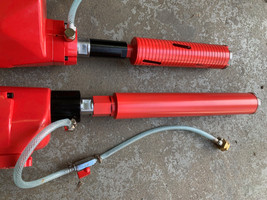Wet vs Dry Concrete Core Drilling. Which core bit works best?
22nd Mar 2019
"Wet or dry, which type of core bit is best?" The answer depends on your specific job and application. Let's compare the two and see how Wet or Dry drilling might be beneficial for you.
Wet Core Drilling
- Requires a water source (all Z-1 core drills are have a metal hose spigot fitting)
- Wet Core Bits use industry standard 1-1/4" - 7 arbor thread size (direct fit on our Z-1 core drills)
- 14.5" Barrel Length
- Job site might require water containment

Usage:
- When done properly, drills faster and more efficiently than dry
- Often drills through concrete, rebar reinforced concrete, brick, softer sedimentary and some harder rocks
- Water aids in suppressing dust and particulate
- Optimal wet drilling requires just the right amount of water to assist the bit in the drilling process without flushing all of the dust particles away. If not enough water is used, the slurry can become paste-like and drilling can be ineffective and slow. The idea consistency is often compared to creamed coffee.
Dry Core Drilling
- Does not require a water source on site
- Concrete dust can be very harmful
- Job site might require dust containment
- Dry Core Bits use industry standard 5/8" - 11 arbor thread size (requires a 1-1/4" to 5/8" #2 or #19 adapter to fit our Z-1 core drills)
- 10" Barrel Depth
Usage:
- Often drills through standard concrete, brick, softer and sedimentary rocks
- Drilling is slower than wet drilling
- Can create excess dust (often contained indoors by draping off the drilling area and use of a shop vacuum)
- Safer when there is potential for contact with live electrical wires
There are many variables to concrete core drilling. When your job site allows for it, we recommend drilling with water. Our BLUEROCK Z-1 core drills are built with an integrated water connection and are directly compatible with our "wet type" coring bits and bit sets.
Contact us with any questions (206) 604-8363 or info@bluerocktools.com

DISCLAIMER: Certain dust created by drilling contains chemicals known to cause cancer, birth defects or other reproductive harm.
TO REDUCE RISK OF EXPOSURE TO THESE CHEMICALS, WORK IN A WELL VENTILATED AREA WITH VACUUM SYSTEMS, RESPIRATORS AND WITH ALL SUITABLE SAFETY EQUIPMENT.

